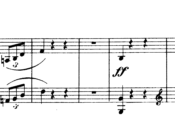Analysis
Contents
Prelude
SUMMARY:
Bars 1-12: Period I. Starting in the Tonic, it ends with a Perfect Cadence in the key of the Relative Minor, D, touching the Dominant (C sharp) along the way (Bars 4-7).
Bars 12-24: Period II. Gently moving to the Minor keys of the Mediant and Supertonic, and returning to the original key.
Bars 24-30: Period III. Dominant Pedal (Bars 26-28). Re-establishing the key. Coda (Bars 24-30).
REMARKS:
The Prelude is founded upon the figures seen in the first few bars.
In Period I, the Treble leads and the Bass responds, in Period II the Bass leads and the Treble responds.
At Bar 6 the Theme is transposed into the key of the Dominant.
Periods I and II are capable of subdivision. In Period I the division occurs in Bar 6, where there is a Perfect Cadence in the Dominant. In Period II the divisions are (1) in Bar 15, where the Cadence is to the Mediant Minor (A sharp); (2) at Bar 18, where the Cadence is to the Supertonic Minor (G sharp); and at Bar 24 the Cadence is definitely in the original key, after which the Coda is commenced.
In the early part of the Coda the opening bars are repeated.
Fugue
ANALYSIS:
ENUNCIATION SECTION:
Bars 1-3: Subject in Treble [F sharp Major].
Bars 3-5: Tonal Answer in Alto. Counter-subject in Treble [C sharp minor].
Bars 5-7: Subject in Bass. Counter-subject in Alto [F sharp minor].
Bars 7-11: Episode I, with a new characteristic figure, modulating from F sharp major to C sharp major.
Bars 11-13: Subject in Treble. Counter-subject in Alto [F sharp major].
MODULATORY SECTION:
Bars 13-15: Episode II, modulating from F sharp major to C sharp Major.
Bars 15-17: Answer in Alto. Counter-subject in Bass [C sharp major].
Bars 17-20: Episode III, modulating from C sharp major to D sharp minor.
Bars 20-22: Subject in Bass. Part of Counter-subject in Alto. Close in D sharp minor [D sharp minor].
Bars 22-28: Episode IV, modulating from D sharp minor to B major.
Bars 28-30: Subject in Alto. Counter-subject in Treble replaced by the figure of the Episodes [B major].
Bars 30-31: Treble and Alto contain imitation of the Subject. New figure in the Bass part.
RECAPITULATORY SECTION:
Bars 31-33: Subject in Treble. Counter-subject in Bass [F sharp major].
Bars 33-35: Coda, based on the characteristic figure of the Episodes [F sharp major].
SUMMARY:
Exposition: Bars 1-13.
Counter-exposition: None.
Stretti: None.
Episodes: Four.
Coda: Bars 33-35.
REMARKS:
- This Fugue has a “tonal” Answer, and would be called a “tonal” Fugue. The alternation in the Answer, for the sake of tonality, is made from the first note to the second.
- An entirely new figure appears in the first Episode, which is do frequently employed in various forms from this point to the end that it almost predominated over both Subject and Counter-subject , and towards the end even supplants the Counter-subject as accompaniment to the Subject.
- Episode I. A new figure is introduced in the Treble and touched upon by the Alto, but eventually entrusted to the Bass to develop fully, the upper parts moving in sharply contrasted counterpoints.
- Episode II. The new figure in the Treble contains in its first few notes a reminiscence of the Subject, imitated by the Alto, the Bass having a florid vivacious figure.
- Episode III. Very much the same in construction as Episode I, the florid figure being still entrusted to the Bass.
- Episode IV. Long consonant suspensions characterize the Treble and Alto, the florid figure being still assigned to the Bass. At Bar 26 this figure is given to the Treble, the Bass and Alto accompanying it in quavers (eighth notes) and minims (half notes) respectively.








